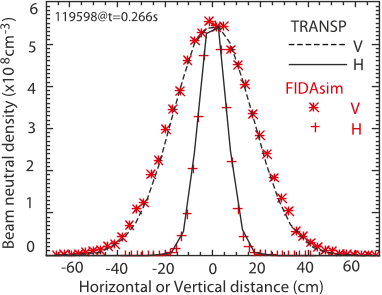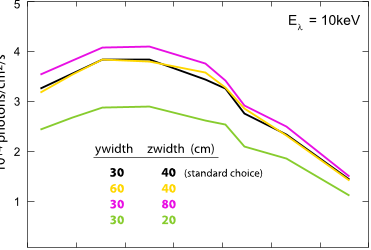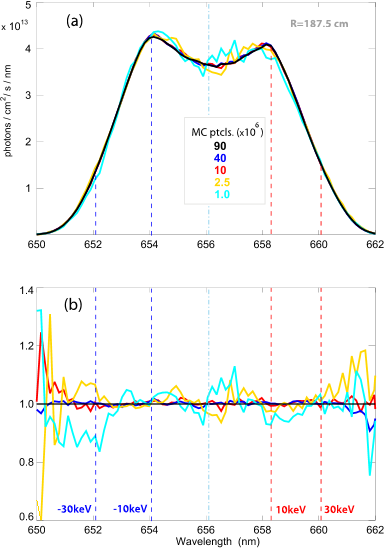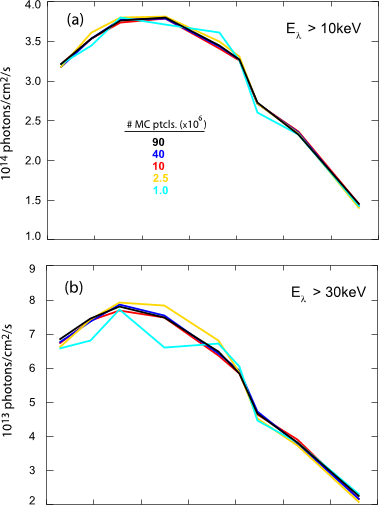
UC Irvine
UC Irvine Previously Published Works
Title
A code that simulates fast-ion Dα and neutral particle measurements
Permalink
https://escholarship.org/uc/item/12f712f4
Journal
Communications in Computational Physics, 10(3)
ISSN
1815-2406
Authors
Heidbrink, WW
Liu, D
Luo, Y
et al.
Publication Date
2011
DOI
10.4208/cicp.190810.080211a
Copyright Information
This work is made available under the terms of a Creative Commons Attribution License,
availalbe at https://creativecommons.org/licenses/by/4.0/
Peer reviewed
eScholarship.org Powered by the California Digital Library
University of California

Commun. Comput. Phys.
doi: 10.4208/cicp.190810.080211a
Vol. 10, No. 3, pp. 716-741
September 2011
A Code that Simulates Fast-Ion D
α
and Neutral
Particle Measurements
W. W. Heidbrink
1,∗
, D. Liu
1,3
, Y. Luo
1,4
, E. Ruskov
1
and
B. Geiger
2
1
Department of Physics and Astronomy, University of California, Irvine,
California, CA 92697, USA.
2
Max-Planck Institute f¨ur Plasmaphysik, Garching, Germany.
3
Department of Physics, University of Wisconsin-Madison, Madison,
WI 53706, USA.
4
Tri Alpha Energy Corporation, 27211 Burbank, Foothill Ranch, CA 92610, USA.
Received 19 August 2010; Accepted (in revised version) 8 February 2011
Available online 1 June 2011
Abstract. A code that models signals produced by charge-exchange reactions between
fast ions and injected neutral beams in tokamak plasmas is described. With the fast-
ion distribution function as input, the code predicts the efflux to a neutral particle
analyzer (NPA) diagnostic and the photon radiance of Balmer-alpha light to a fast-
ion D
α
(FIDA) diagnostic. Reactions with both the primary injected neutrals and with
the cloud of secondary ”halo” neutrals that surround the beam are treated. Accurate
calculation of the fraction of neutrals that occupy excited atomic states (the collisional-
radiative transition equations) is an important element of the code. Comparison with
TRANSP output and other tests verify the solutions. Judicious selection of grid size
and other parameters facilitate efficient solutions. The output of the code has be en
validated by FIDA measurements on DIII-D but further tests are warranted.
PACS: 52.55.Pi, 52.65.Pp, 52.70 .Kz
Key words: Fast ions.
1 Introduction
Supra-thermal populations of energetic ions play an important role in magnetic fusion
research. These ”fast ions” are created by neutral-beam injection, by RF heating, and in
fusion reactions. The distribution function that describes t h ese populations ge n erally is a
∗
Corresponding author. Email addresses: Bill.Heidbrink@uci.edu (W. W. Heidbrink), dliu29@wisc.edu ( D.
Liu), yluo@trialphaenergy.com (Y. Luo), eruskov@uci.edu (E. Ruskov), bgeiger@ipp.mpg.de (B. Geiger)
http://www.global-sci.com/ 716
c
2011 Global-Science Press

W. W. Heidbrink et al. / Commun. Co mput. Phys., 10 (2011), pp. 716-741 717
complicated function of velocity and configuration-space variables. Measuring the fast-
ion distribution function in the harsh magnet ic fusion environment is a major diagnostic
challenge.
One approach is to exploit charge exchange reactions between energetic deuterium
ions and an injected neut r al beam. Collection of escaping n eutrals is t h e basis of neutral
particle analysis (NPA) [1], a te chnique that has been applied to tokamak plasmas for
nearly five decades [2]. A more recent technique is to analyze the visible photons emitted
by hyd rogenic fast ions that neutralize in the injected beam [3]. A review of these fast-ion
D
α
(FIDA) me asurements was recently published [4].
Both NPA and FIDA diagnostics provide valuable information about the fast-ion dis-
tribution function but also depend se n sitively on other plasma parameters and on atomic
cross sections. One way to relate the measured signals to theory is to construct a phase-
space weight function for each me asurement [5]; the signal is the convolution of the fast-
ion distribution function with the weight function. As illustrated by the examples in [4],
this approach is quite useful for rapid qualitative interpretation of the measurements. It
can also be the basis for an inversion algorithm. Although the processes are too com-
plicated for a unique inversion [6], a least-squares minimization scheme that utilizes a
weight function can dete r mine which model distribution function agrees best with the
data. An example of inference of the d istribution function from collective Thomson scat-
tering data was recently published [7].
Alternatively, one can use forward modeling. In this approach, the distribution func-
tion is a given quantity supplied by theory. The code described in this paper, dubbed
FIDASIM, takes this approach. FIDASIM accepts a theoretical distribution function as
input and predicts FIDA and NPA spectra for comparison with the data. The code is
designed to comput e ”active” s ign als produced by an injected neutral beam. (In real-
ity, collisions with edge neutrals also produce FIDA and NPA signals but the code does
not treat these ”passive” reactions.) To date, the code has been used to model measure-
ments on the DIII-D and ASDEX-Upgrade conventional tokamaks and on the NSTX and
MAST spherical t okamaks. An early version of the code was described in the Appendix
of [3]. This paper describes version 3.0 and is organized as follows. Section 2 presents
the assumptions and organization of the code. Section 3 describes tests that verify that
the code correctly solves the desired equations. Section 4 explains the optimal selection
of n umerical parameters in terms of phy sical processes. Section 5 summarizes validation
by experiment. Section 6 provides an outloo k for further tests and improvements.
2 Model
The code has fou r main sections (Fig. 1). The first section prepares the data and the
second calculates t h e neut r al populations. The third and fourth sections bo th rely on the
first two sections but are indepen dent of each other. One s ection comp utes the NPA flux
and the other computes the FIDA radiance.

718 W. W. Heidbrink et al. / Commun. Comput. Phys., 10 (2011), pp. 716-741
1HXWUDO%HDP*HRPHWU\
'HWHFWRU*HRPHWU\
(TXLOLEULXP
3ODVPD3URILOHV
1XPHULFDO3DUDPHWHUV
&UHDWH0HVK
(%)LHOGV
)XOO
GHQVLWLHVLQ
HDFKQVWDWH
+DORJHQHUDWLRQ
%(6VSHFWUD
0RQWH&DUOR,QMHFWHG
1HXWUDO*HQHUDWRU
)ROORZ"
1
<
D
W
D
'
W
X
S
Q
,
7UDMHFWRU\
,QYU
2XWWLPHLQFHOOV
V
O
O
H
F
U
H
Y
R
S
R
R
/
Q
R
L
W
D
]
L
O
D
L
W
L
Q
,
0RQWH&DUOR)LUVW*HQHUDWLRQ
+DOR1HXWUDO*HQHUDWRU
7UDMHFWRU\
,QYU
2XWWLPHLQFHOOV
&;"
<
1
,RQL]H"
<
1
O
O
H
F
W
[
H
Q
\
W
L
V
Q
H
'
O
D
U
W
X
H
1
\
U
D
P
L
U
3
\
W
L
V
Q
H
'
O
D
U
W
X
H
1
R
O
D
+
[
X
O
)
$
3
1
)DVWLRQ'LVWULEXWLRQ
3ULPDU\1HXWUDO'LVWULEXWLRQ
+DOR1HXWUDO'LVWULEXWLRQ
3KRWRQ9HFWRUV
$WRPLF5DWHV
VS
VR
V
L
L
),'$5DGLDQFH
0DS3ODVPD3URILOHV
)DVWLRQ'LVWULEXWLRQ0DS'LVWULEXWLRQ
13$VSHFWUD
'LUHFW&;
VSHFWUD
+DORVSHFWUD
Figure 1: Flow diagram for the FIDASIM code.
2.1 Input data and coordinate mapping
The code begins by collecting the input data. The geome try o f the source of injected neu-
trals is specified first. In some devices (such as NSTX) the detector sightlines intersect
several beams, so the code can accommodate multiple beam lines. The code uses the
conventions of the NUBEAM module [8] of the TRANSP code [9] to describe the geome-
try of the viewed neutral beam source (or sources). Each tok amak has its own subroutine
called, e.g., BEAM GEOMETRY D3D. As in NUBE AM, the neutral beam is described by
rectangular source and aperture dimensions and by fo cal lengths and d ivergences in both
the horizontal and ve r tical directions. The beam energy, power, and species mix between
full-energy, h alf-energy, and third-energy components are also input parameters.

W. W. Heidbrink et al. / Commun. Co mput. Phys., 10 (2011), pp. 716-741 719
Next, th e code collects information about the detector locations and sightlines. For
FIDA, the ”detector” location is actually t h e position of the primary lens (or mirror) of the
collection optics, s ince it is this position that det ermines the Doppler shift of th e emitted
radiation. For an NPA, bot h the sightlines and the solid angles are specified.
Information on the equilibrium is input using the so-called ”eqdsk” format produced
by the EFIT equilibrium code [10]. For installations that do not use EFIT, a post-processor
that is part of the TRANSP distribution can convert TRANSP output files into the desired
format.
The code requires profiles of electron density and temp erature, ion temperature and
toroidal rotation, and impurity de n sity as a function of flux sur face. (Th ese quantities are
all assumed to be flux functions.) A subroutine exists that conver ts TRANSP o utput into
the d esired format.
The final major piece of input data is the theo retical fast-ion distribution function,
which can have a complicated dependence on energy E, pitch p =v
k
/v, and space r. (As
in TRANSP, pos itive p is defined by the direction of the plasma current rather than by
the d irection of the toroidal field.)
Three distinct coordinate systems are utilized in t h e initial stages of t h e code (Fig. 2).
The beam and dete ctor geometries are specified in right-handed Cartesian (u,v,z) coor-
dinates w ith origin the center of the tokamak and z the vertical direction. Plasma pa-
rameters are one-dimensional functions of flux coordinates. Because neutrals travel in
Figure 2: Plan view of NSTX. Geometrical neutral beam and detector input to the code is in (u,v,z) coordinates.
Neutral beam parameters (upper case labels) follow the TRANSP conventions. The code transforms quantities
into (x,y,z) co ordinates along the selected beam.













